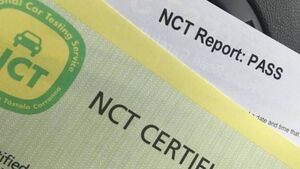Over half of cars tested fail NCT in Kildare

NCT cert
There were over 3,500 dangerously defective cars being driven on Kildare roads last year.
The NCT failed over half of cars it tested in Co Kildare last year with over one in 20 classified as “fail dangerous”.
Kildare had the second lowest proportion of “fail dangerous” classifications in the country.
There were 57,800 NCT tests conducted in Kildare last year. 27,589 passed the test, rate pf 47.7 per cent.
26,542 (45 per cent) were identified with a major fault and failed while 3,658 (6.35 per cent) were deemed dangerously defective.
The national rate of dangerously defective cars was 7.42 per cent, a record rate.
A vehicle categorised as “dangerous fail” is found to have a dangerous defect that constitutes a direct or immediate risk to road safety such that it should not be used on the public road under any circumstances.
A sticker stating “Failed Dangerous” will be affixed to the vehicle by a NCTS vehicle inspector who will also inform the motorist why and how their car is dangerous and unroadworthy According to Applus+ – the Spanish company that operates the NCT on behalf of the Road Safety Authority at 50 test centres in the Republic – NCTS vehicle inspectors will also advise the owners of dangerously defective cars to have them towed away from the centre.
The company said customers are also read a statement that if they drive the vehicle off the premises, the NCTS will inform An Garda Síochána that a dangerous defective vehicle was just driven from the centre.
Applus+’s communications manager, Sinéad McKeon, said the reaction of motorists with a “fail dangerous” vehicle is mixed with some ignoring the warnings and driving off in their car from the test centre.
Ms McKeon said the high level of “fail dangerous” vehicles was probably linked to people not servicing their car on a regular basis.
“People don’t check on their car in advance of going in for a test and they are using the NCT as a diagnostic tool instead of getting their vehicle services first,” she added.
Some of the main reasons for a vehicle receiving a “fail dangerous result” include badly corroded bodywork; bald, bulging or damaged tyres; brake fluid leaks; car doors that do not close properly and brake lights not working.
At a county level, the highest share of “fail dangerous” vehicles last year was recorded in Cavan where 11.9 per cent of cars tested were dangerously defective.
The lowest proportion of vehicles to be classified as “fail dangerous” was found in Offaly (6.1 per cent); Kildare (6.3 per cent); Louth and Waterford (both 6.7 per cent); Dublin and Wicklow (both 6.8 per cent) and Kilkenny (7.0 per cent).
The latest NCTS figures also show that the pass rate for the full test has fallen to its lowest level in five years at 50.6 per cent nationally – down from 52.9 per cent in 2023 and the recent high rate of 54.3 per cent in 2022.
The most common fault detected during checks on over 1.7 million vehicles last year related to steering and suspension which affected 15.0 per cent of all vehicles followed by lighting and electrical (14.2 per cent) and the side slip test (12.3 per cent) which checks on wheel alignment.





